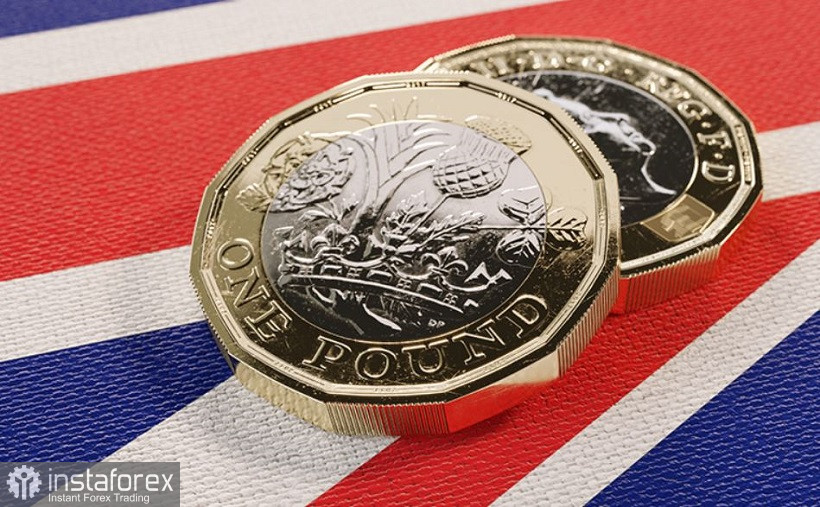The pound-dollar pair follows the general trends of today: the US currency is retreating throughout the market, and its opponents are trying to build on their success by organizing corrective counterattacks. Due to the weakening of the dollar, bulls on GBP/USD were able to partially offset their losses – the price approached the boundaries of the 17th figure, although last week the pair was at the base of the 14th price level. The growth dynamics is impressive, but on the other hand, we must not forget that this momentum is due only to the decline in the dollar index. Under the circumstances, the pound is forced only to follow the US dollar. The Brits are unlikely to be able to hold their positions if the dollar starts gaining momentum again throughout the market.
It is noteworthy that the GBP/USD pair is showing positive dynamics amid the release of disappointing data on the growth of the UK economy. The latest reports came out in the red zone, but bulls took advantage of the moment and ignored this fact. But this is a very deceptive situation. The latest release is a "deferred action" release. It will remind you of itself, especially when the subsequent macroeconomic reports, which will be published this week, will crystallize the overall picture.

British Prime Minister Liz Truss is also a "dark horse" here – she can also put significant pressure on the British currency, given the ideas in the field of taxation that she declared during the election race. However, it can be assumed here that the first decisions of a political and economic nature will be taken at Downing Street no earlier than September 19, when the funeral of Queen Elizabeth II will take place. By the way, the September meeting of the Bank of England was also postponed (to September 22) due to mourning.
The latest macroeconomic reports reflected the weak growth of the British economy. The volume of UK GDP in July increased by 0.2% on a monthly basis, while most experts expected a more significant increase of 0.5%. In annual terms, the indicator came out at zero. The volume of industrial production decreased altogether – by 0.1% (m/m). The production volume of the processing industry grew slightly (0.1%). I repeat – all the indicators fell short of the forecast estimates, and very modest forecast estimates.
The latest report is not the only one in a series of important macroeconomic reports. Data on the labor market will be published on Tuesday, and inflation indicators on Wednesday. Also, do not forget that data on the growth of US inflation will be released on Tuesday. And if by that time the correction of the US dollar index is completed, GBP/USD traders will focus their attention on these reports. In conditions of such uncertainty, it is too risky to open any trading positions on the pair. And although, in my opinion, the pound will remain under pressure in any case (in the medium term), a larger-scale corrective breakthrough cannot be ruled out - for example, to the level of 1.1840.
According to preliminary data, the unemployment rate in the UK will remain at the same level – 3.8%. The rate of increase in the number of applications for unemployment benefits should be reduced by 10,000. Salaries should demonstrate positive dynamics (the increase in the level of average earnings may amount to 5.4%).
As for inflation, the growth of the main indicators is also expected here. The overall consumer price index should jump to 10.2% in annual terms. A similar trend is likely to be demonstrated by the main CPI – an increase to 6.3% is expected here. The retail price index and the purchasing price index should complement the overall inflationary picture.
It should be noted that a further increase in inflation amid weak economic growth does not bode well for the British currency. And especially if the data in the labor market disappoint. Let me remind you that in September, some officials of the BoE voiced a rather restrained position on the pace of rate hikes. For example, Committee member Silvana Tenreyro said that a more gradual pace of tightening reduces the risk of "excessive increases." At the same time, she added that the British central bank "should act slowly and cautiously", in conditions of great uncertainty. In general, according to the results of the parliamentary hearings that took place last week, the probability of a 75-point rate hike at the September meeting has significantly decreased – from 70% to 50%. Therefore, the pound cannot now count on the "support" of the British central bank ahead of the September meeting: hawkish expectations have weakened, and this fact exerts background pressure on the pound.
While the probability of the Federal Reserve raising the rate by 75 points in September has already jumped by almost 90%. And Tuesday's report on the growth of US inflation in this context plays a rather formal role. Further CPI growth in the US or its slowdown will be viewed by the market only through the prism of further rates of tightening of the Fed's monetary policy.
Thus, it is risky to trust the current growth of GBP/USD in the current conditions. The corrective decline of the US currency may end suddenly (for example, as a reaction to Tuesday's inflation release), while the pound will not be able to "pick up the falling banner". In my opinion, it is now advisable to take a wait-and-see position - until the end of the GBP/USD correction.





















